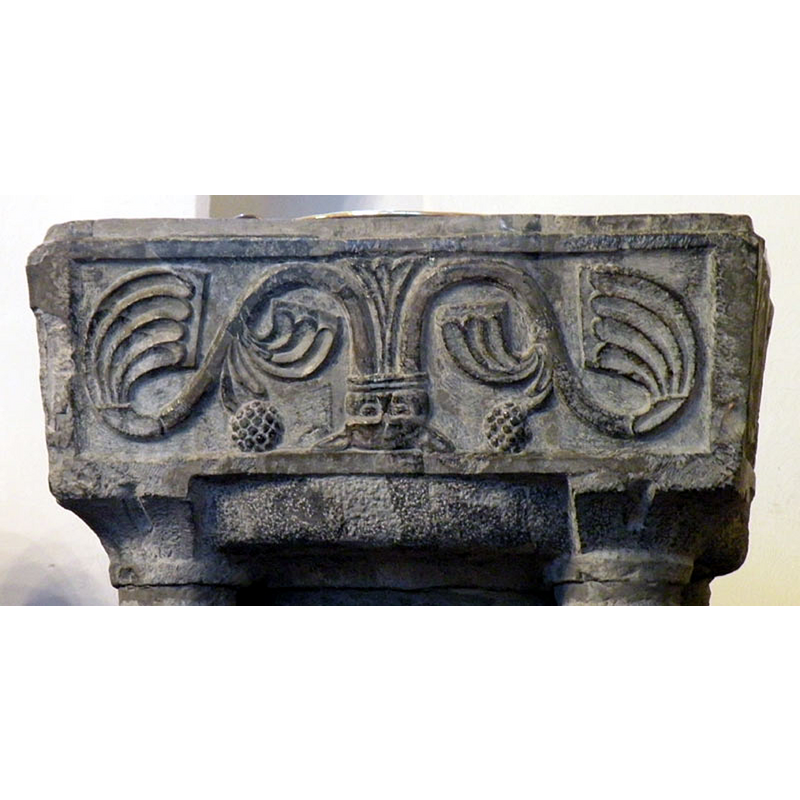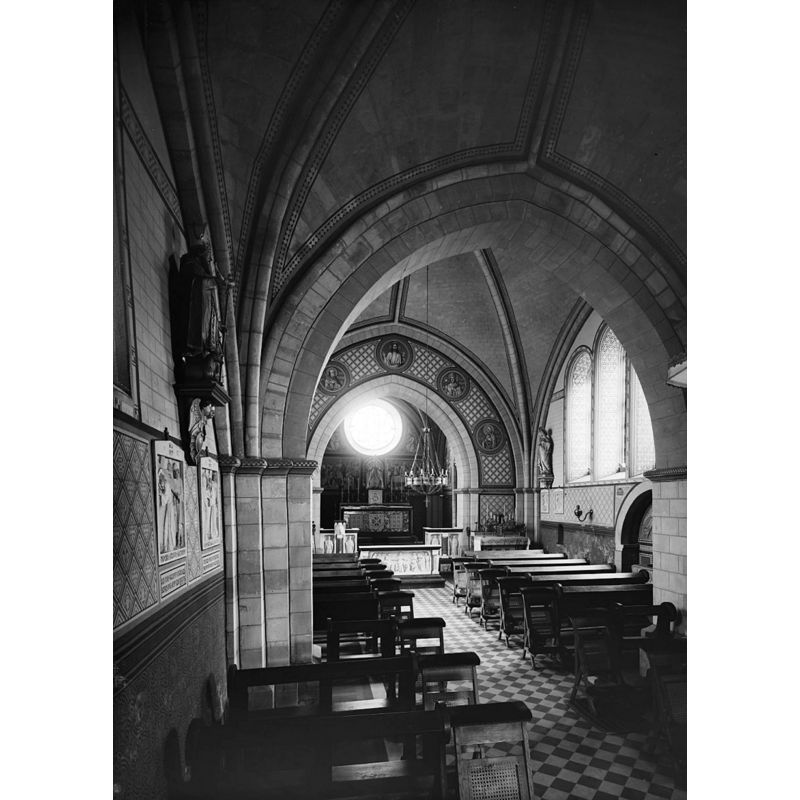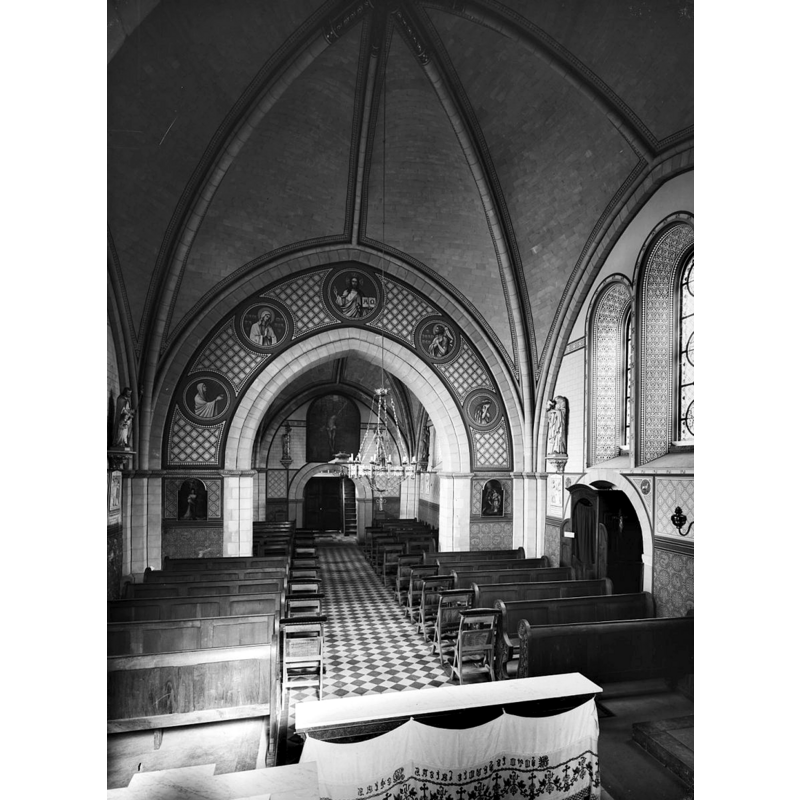Asselt / Ascaloha / Aschlo / Ascloha / Aslao / Assel / Hasselt

Image copyright © Rijksdienst voor het Cultureel Erfgoed, 2015
CC-BY-SA-3.0-NL
Results: 12 records
animal - mammal - lion - head - vegetation stemming from its mouth - upturned - 4
Scene Description: one on each side of the basin
Copyright Statement: Image copyright © [s.n., s.d.]
Image Source: photograph, origin unknown, reproduced in [www.loegiesen.nl/toponiemen/Dionysiuskerk_Asselt.htm] [accessed 28 March 2015]
Copyright Instructions: No known copyright restriction / Fair Dealing
design element - motifs - vine - acanthus - bearing fruit - arum
Scene Description: stemming from an inverted lion's head; two on each side of the basin
Copyright Statement: Image copyright © [s.n., s.d.]
Image Source: photograph, origin unknown, reproduced in [www.loegiesen.nl/toponiemen/Dionysiuskerk_Asselt.htm] [accessed 28 March 2015]
Copyright Instructions: No known copyright restriction / Fair Dealing
head - 4
Scene Description: two animal and two human [cf. FontNotes for details]
Copyright Statement: Image copyright © Stichting Databank Kerkgebouwen in Limburg, 2014
Image Source: photo: augustus 2008, in Stichting Databank Kerkgebouwen in Limburg [www.kerkgebouwen-in-limburg.nl/kerken/asselt/dionysius] [accessed 28 March 2015]
Copyright Instructions: No known copyright restriction / Fair Dealing
head - 4
Scene Description: two animal and two human [cf. FontNotes for details]
Copyright Statement: Image copyright © Stichting Databank Kerkgebouwen in Limburg, 2014
Image Source: photo: augustus 2008, in Stichting Databank Kerkgebouwen in Limburg [www.kerkgebouwen-in-limburg.nl/kerken/asselt/dionysius] [accessed 28 March 2015]
Copyright Instructions: No known copyright restriction / Fair Dealing
head - 4
Scene Description: two animal and two human [cf. FontNotes for details]
Copyright Statement: Image copyright © Stichting Databank Kerkgebouwen in Limburg, 2014
Image Source: photo: augustus 2008, in Stichting Databank Kerkgebouwen in Limburg [www.kerkgebouwen-in-limburg.nl/kerken/asselt/dionysius] [accessed 28 March 2015]
Copyright Instructions: No known copyright restriction / Fair Dealing
head - 4
Scene Description: two animal and two human [cf. FontNotes for details]
Copyright Statement: Image copyright © Stichting Databank Kerkgebouwen in Limburg, 2014
Image Source: photo: augustus 2008, in Stichting Databank Kerkgebouwen in Limburg [www.kerkgebouwen-in-limburg.nl/kerken/asselt/dionysius] [accessed 28 March 2015]
Copyright Instructions: No known copyright restriction / Fair Dealing
view of church exterior - northwest view
view of church interior - nave - looking east
Scene Description: photograph taken around the time of the restoration of this church and font
Copyright Statement: Image copyright © Rijksdienst voor het Cultureel Erfgoed, 2015
Image Source: B&W photograph taken in April 1920, Rijksdienst voor het Cultureel Erfgoed [http://commons.wikimedia.org/wiki/File:Interieur_naar_het_noord-westen_-_Asselt_-_20025927_-_RCE.jpg] [accessed 28 March 2015]
Copyright Instructions: CC-BY-SA-3.0-NL
view of church interior - nave - looking east
Scene Description: photograph taken around the time of the restoration of this church and font
Copyright Statement: Image copyright © Rijksdienst voor het Cultureel Erfgoed, 2015
Image Source: B&W photograph taken in April 1920, Rijksdienst voor het Cultureel Erfgoed [http://commons.wikimedia.org/wiki/File:Interieur_naar_het_noord-westen_-_Asselt_-_20025928_-_RCE.jpg] [accessed 28 March 2015]
Copyright Instructions: CC-BY-SA-3.0-NL
view of font and cover in context
Scene Description: Source caption: "Katholieke Kerk Van De H. Dionysius: Interieur, doopvont (opmerking: In marge gedrukte tekst: C.G. Weers Hoffotograaf Roermond)" [NB: the photograph was probably taken soon after the 1920 restoration of the church and font]
Copyright Statement: Image copyright © Rijksdienst voor het Cultureel Erfgoed, 2015
Image Source: undated photograph taken by Weers, C.G. (Fotograaf), in Rijksdienst voor het Cultureel Erfgoed [http://commons.wikimedia.org/wiki/File:Interieur,_doopvont_-_Asselt_-_20320396_-_RCE.jpg] [accessed 28 March 2015]
Copyright Instructions: CC-BY-SA-3.0-NL
view of font and cover in context
Scene Description: though undated, the photograph appears to show the font through an outer wall [north?]; the font is topped with the same font cover that would be retained after the restoration
Copyright Statement: Image copyright © [s.n., s.d.]
Image Source: photograph, origin unknown, reproduced in [www.loegiesen.nl/toponiemen/Dionysiuskerk_Asselt.htm] [accessed 28 March 2015]
Copyright Instructions: No known copyright restriction / Fair Dealing
INFORMATION
FontID: 10833ASS
Object Type: Baptismal Font1
Church/Chapel: Sint-Dionysiuskerk / Eglise paroissiale Saint-Denis
Church Patron Saints: St. Denys [aka Denis, Dennis, Dionis, Dyonisius]
Church Location: Pastoor Pinckersstraat 3, 6071 NW Swalmen, Netherlands
Country Name: Netherlands
Location: Limburg
Directions to Site: Located off (W) the A73, in the municipality and 3 km NNW of Roermond, 15 km SW of Venlo
Ecclesiastic Region: Diocèse de Liège
Font Location in Church: Inside the church [cf. FontNotes]
Date: ca. 1160?
Century and Period: 12th century (mid?), Romanesque
Workshop/Group/Artisan: Mosan font
Cognate Fonts: [cf. FontNotes]
Credit and Acknowledgements: We are grateful to Pol Herman for his help in documenting this font
Church Notes: original church before 1000 AD; late-Gothick brick tower 1515; church restored 1916-1917
Font Notes:
Click to view
Mosan baptismal font consisting of a square basin raised on a five-column support. Noted in Ghislain (1986) as one of a group of Mosan fonts [Achêne, Asselt, Bastogne, Gentinnes and Zonhoven] that include the motif of a feline head with branches of palmette and/or grape-vines stemming from its mouth. Described and illustrated in Drake (2002): "On the base at Asselt [...] the roll-mouldings which form the sockets for the colonnettes are carved to form faces which look diagonally outwards to the corners. Two are human, one with unnaturally large ears, and the other two seem to represent a pig and a wolf, representing the forves of evil which lie in wait for the unwary." A note in the same source explains that "the bowl of this font was found in pieces, being used as building material in the tower of the church at Tegelen. It seems to be not a precise fit with the base, which was already in the Asselt church." The sides of the basin are decorated with a traditional pattern: each side has a little upside-down lion head in the lower part of the centre, from which stem two acanthus vines, left and right, forming the common round pattern and bearing fruit[sarum?]; this decoration is framed in plain flat mouldings that delineate each panel of the square font. Catalogued and illustrated in Ghislain (2009) as a baptismal font of the Namurois group, filiation de Saint-Séverin-en-Condroz, made of limestone (calcaire viséen ou dévonien) ca. 1160; the details of the recovery and restoration of the font complement those of Drake [cf. supra], and the font was completed in 1920 by Karel Lucker. Listed in www.romanicoportugal.info/zdutchfonts.htm [accessed 2 July 2015]. [NB: a lengthy communication from Pol Herman (e-mail of 17 December 2021) informs of a long debate about the fragments of a font [?] that ended up in two churches, those of Asselt and Tegelen. The standing argument had to do with the claim by Ferdinand (Fred) Hestermann that the basin in Tegelen originated in Asselt, while professor Raphaël Ligtenberg had argued that the sizes of basin and base/columns of Romanesque fonts where somewhat standardized, and that the probability is high that an any old basin will fit some old base. According to him, there was no reason to assume that the fragments of Asselt and Tegelen were of the same font. The issue reached the newspapers, as can be senn in the examples below provided by Pol Herman. The document “Geschiedenis van Asselt” takes the view of Asselt. Hestermann is called “the well known specialist in the study of old baptismal fonts, who was investigating the fragments of old finds in Limburg and in the Rhine province since two years” He happened to be visiting and saw the fragments of the basin at Tegelen and made an investigation without making publicity about it. The document “Een oude doopvont uit een kerkje van Asselt” describes how the base was found at Asselt in 1916. How after the fire at the church of Tegelen in 1898, fragments of a basin were found. How Hestermann, who was making a special study on baptismal fonts in the Rhineland, Belgium and Limburg, rediscovered the fragments of Tegelen in 1919. Hestermann concludes that Ligtenberg oversaw arguments. Because Hestermann had visited Asselt and had seen the base, he concluded that the dimensions fitted. You can see his sketch in this document. The priest of Asselt then tried to acquire the fragments of Tegelen, in vain. However, when rector Mobius had to undergo surgery in the hospital, the fragments of Tegelen were quickly moved to Asselt based on an unsigned approval telegram whose sender was never identified. In the week of 18-23 November 1919, the repaired font was consecrated at Asselt. This led to bitter disputes that were settled amicably. In a newspaper article of 4th of December 1919, an anonymous author explains why it is sure that the fragments of Tegelen belong to Asselt. But he also writes : “One day Hestermann came to Asselt and saw the base and column of the old baptismal font, and he promised that if he ever found the missing basin during his study trips, he would try to get it back for Asselt. Little did he suspect then that he would find them so quickly in the immediate vicinity”.In a newspaper article of 9th of December 1919, Hestermann defends his opinion and behaviour. In a newspaper article of 18th of December 1928, an anonymous former priest of Tegelen argues that the basin was originally from the church of Tegelen and should have stayed there. How the Tegelen priest of that time had shown too little respect for old objects. That a fitting basin and base does not mean that they are from the same font. That it is improbable that fragments of the broken Asselt font would have been moved to Tegelen, to be used in the foundation of the new Tegelen church, given that it was a 3 to 4 hours voyage and that plenty of building material for the foundation was available at Tegelen coming from the demolition of the old Tegelen church, etc.] A further communication from Pol Herman (e-mail of 18 December 2021) notes: "The story of Asselt and Tegelen is even more puzzling. If the 33 basin fragments found at Tegelen allowed Karel Lückel to reassemble the complete basin (with 4 identical faces), why is there a fragment of a circular Romanesque baptismal font (showing an ouroboros) in the wall of the tower of the Tegelen church?"
COORDINATES
Church Latitude & Longitude Decimal: 51.225019, 6.011706
Church Latitude & Longitude DMS: 51° 13′ 30.07″ N, 6° 0′ 42.14″ E
UTM: 32U 291349 5679092
MEDIUM AND MEASUREMENTS
Material: stone, limestone (calcaire viséen ou dévonien)
Font Shape: square (mounted)
Basin Interior Shape: round
Basin Exterior Shape: square
Drainage Notes: the inner basin is completely cemented over and shows no drain now
Diameter (inside rim): 56 cm*
Basin Depth: 26.5 cm* [cemented over]
Basin Total Height: 36 cm*
Trapezoidal Basin: 75 x 75 cm*
LID INFORMATION
Material: metal, brass
Apparatus: no
Notes: dome with Crucifixion finial
REFERENCES
Drake, Colin Stuart, The Romanesque Fonts of Northern Europe and Scandinavia, Woodbridge, Suffolk: Boydell Press, 2002
Ghislain, Jean-Claude, "La cuve baptismale romane de Wauthier-Braine", VII, Annales du Cercle historique et folklorique de Braine-le-Château, Tubize et des Régions voisines, 1986, pp. 89-[120]; p. 96, 98
Ghislain, Jean-Claude, Les fonts baptismaux romans en pierre bleue des ateliers du Namurois (ca. 1150-1175), Namur: Musée provincial des arts anciens du Namurois, 2009

![two animal and two human [cf. FontNotes for details]](/static-50478a99ec6f36a15d6234548c59f63da52304e5/compressed/1150328021_compressed.png)
![two animal and two human [cf. FontNotes for details]](/static-50478a99ec6f36a15d6234548c59f63da52304e5/compressed/1150328022_compressed.png)
![two animal and two human [cf. FontNotes for details]](/static-50478a99ec6f36a15d6234548c59f63da52304e5/compressed/1150328023_compressed.png)
![two animal and two human [cf. FontNotes for details]](/static-50478a99ec6f36a15d6234548c59f63da52304e5/compressed/1150328024_compressed.png)



![though undated, the photograph appears to show the font through an outer wall [north?]; the font is topped with the same font cover that would be retained after the restoration](/static-50478a99ec6f36a15d6234548c59f63da52304e5/compressed/1150328017_compressed.png)
